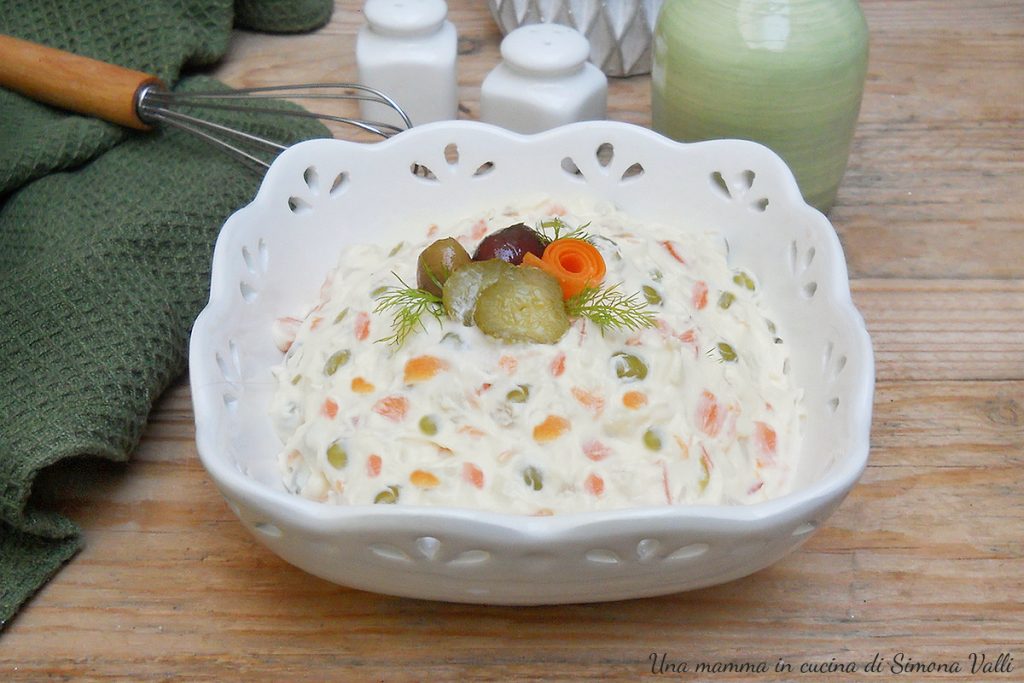The Russian salad is one of the most well-known and loved appetizers, it is a simple salad to prepare that should never be missing during festivities and can also be served as a side dish. Its origin is uncertain, with many hypotheses about its creation; traces of it can be found already in the mid-1800s in various countries and in several cookbooks, but the recipes are so different that it is impossible to trace its origin.
The most accredited hypothesis attributes it to Lucien Olivier, a Russian chef of Belgian origin who invented it in the mid-1800s for the guests of the prestigious Hermitage restaurant in Moscow, making it the symbolic dish of the place for over 50 years. The recipe for Russian salad was completely different from the one we know today, the main ingredient was meat from various animals, which is not found at all in the Italian version, combined with truffles, jellies, anchovies, capers, and olives.
The Russian salad has many variations even though the classic version is composed of cooked vegetables, pickled gherkins, and mayonnaise; it is often enriched with desalted capers, hard-boiled eggs, and sometimes canned tuna. Today I present the classic recipe.
Also try the other salads:

- Difficulty: Easy
- Cost: Affordable
- Preparation time: 35 Minutes
- Portions: 8 People
- Cooking methods: Boiling
- Cuisine: Italian
- Seasonality: All seasons, Christmas
- Energy 350.95 (Kcal)
- Carbohydrates 17.67 (g) of which sugars 2.99 (g)
- Proteins 3.65 (g)
- Fat 30.43 (g) of which saturated 3.52 (g)of which unsaturated 19.86 (g)
- Fibers 3.42 (g)
- Sodium 452.95 (mg)
Indicative values for a portion of 100 g processed in an automated way starting from the nutritional information available on the CREA* and FoodData Central** databases. It is not food and / or nutritional advice.
* CREATES Food and Nutrition Research Center: https://www.crea.gov.it/alimenti-e-nutrizione https://www.alimentinutrizione.it ** U.S. Department of Agriculture, Agricultural Research Service. FoodData Central, 2019. https://fdc.nal.usda.gov
Ingredients
- 14 oz potatoes
- 10.5 oz carrots
- 7 oz peas (fresh or frozen)
- 3.5 oz pickled gherkins
- 2 tbsp extra virgin olive oil
- 1 tbsp white wine vinegar
- to taste salt
- 10.5 oz mayonnaise
- 2 egg yolks (pasteurized, about 26/28g)
- 9 oz sunflower oil
- 1.75 oz extra virgin olive oil (or more sunflower oil)
- 0.35 oz lemon juice
- 0.18 oz white wine vinegar
- 0.11 oz mustard (optional)
- to taste salt
Tools
- 1 Immersion blender
- 1 Pan
- 1 Chopping board
- 1 Bowl
- 1 Scale
- Peeler
Procedure
To prepare the mayonnaise, I use pasteurized egg yolks that I buy in cartons at the supermarket, this operation avoids salmonella contamination. If you prefer, you can use fresh yolks at your own risk. The alternative is to pasteurize the mayonnaise by heating the oil to 250°F, but using pasteurized eggs or yolks is much faster and practical.
Mix the sunflower oil with the extra virgin olive oil, if it’s too strong for you, use only seed oil.
Place the yolks in the immersion blender beaker (you can also use a Thermomix), add the salt, lemon, vinegar, mustard, and turn on the blender at medium power while pouring the oil in a thin stream until it’s all used up.
The mayonnaise is ready.
Wash the carrots and potatoes very well, peel them with the peeler, and cut them into 0.4-inch cubes, keeping them separate.
Bring lightly salted water to a boil in a pan, then cook the carrots for 5-6 minutes and drain them.
Boil the peas for 3 minutes and drain them. Finally, cook the potatoes for 6-7 minutes (while the other vegetables can be slightly crunchy, the potatoes should be cooked but not falling apart) and drain them.
Let them cool and dry well so that they do not release water, then transfer them to a large bowl.
Add the thinly sliced gherkins to the vegetables and season everything with oil, vinegar, and salt.
Add the mayonnaise and mix well but gently.
The Russian salad is ready; you can serve it in individual portions or pour it onto a plate, shape it into a dome, and decorate with hard-boiled eggs and fresh vegetables.
Tips
Russian salad, if well made, can be stored in the fridge in an airtight container for 1 week.
It cannot be frozen.
*******************
For tips on making recipes, contact me on FACEBOOK and if you like, follow me on INSTAGRAM.
Send me your photos, I will gladly publish them on my social media

